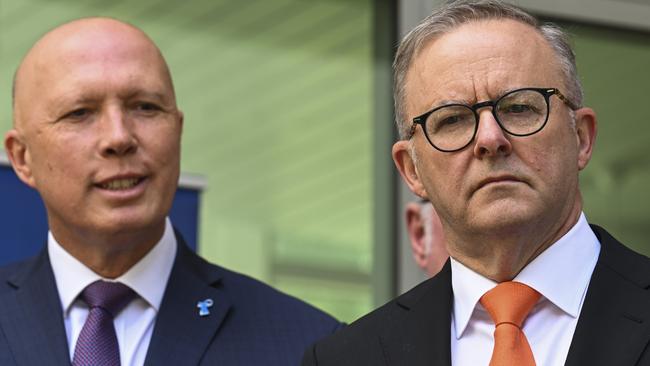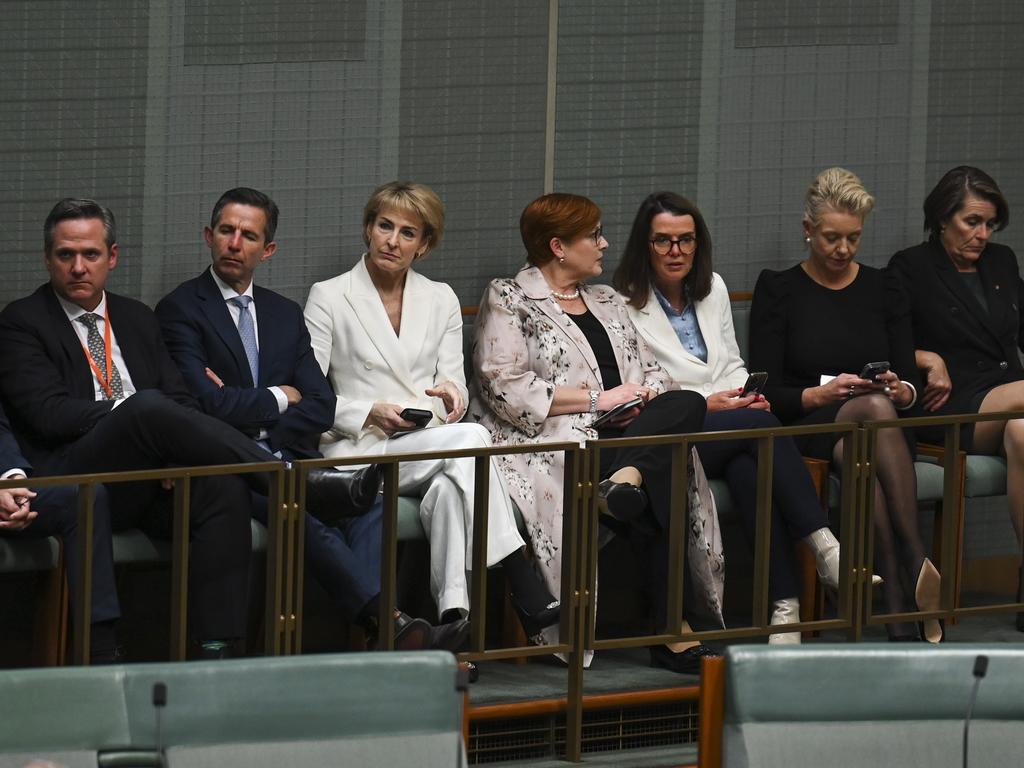Anthony Albanese, Peter Dutton battle for the heart of middle Australia
It’s a race against time as Peter Dutton and Anthony Albanese vie over economic management and energy policy.

At the same time Dutton is moving towards a breakout from the defensiveness of the Coalition’s climate change policies with a more intense call for small modular nuclear technology – injecting a new political wedge into the energy debate and creating a fault line between Labor and Liberal given the Albanese government’s hostility to any hint of nuclear energy.
On display this week is a now established Labor government, politically astute, policy cautious and thinking long-term, facing a Liberal leader offering a variation of the party orthodoxy by strengthening the economy, championing middle Australia and buttressing national security.
With Australia facing slower economic growth, ongoing high inflation, still negative real wages, weak productivity, falling business confidence, reduced per capita income, and housing, rent and cost-of-living pressures, Dutton’s tactic is to hold the Albanese government to account in the hope that, sooner or later, the public will blame the government for its woes.
But the budget’s optimistic forecasts, if realised, suggest economic and living standard improvements will arrive before the next election.
So Dutton is racing against time: he must claw back some of Anthony Albanese’s polling ascendancy before the expected boost in economic conditions.
The second budget by Jim Chalmers is a series of conundrums – modest decisions yet big ideas; epic fiscal consolidation with almost no electoral pain; conspicuous political caution amid declarations of long-run ambition.
Labor has the zeitgeist with it – yet it hovers between the strange extremes of confidence spilling into hubris and a reluctance to take hard decisions that points to missed opportunity. The real story is that Labor operates in a world of transformed politics. The days of tough spending cuts are long gone because a compassion-sensitive public will not tolerate them.
The Albanese government displays fiscal discipline but it is born from Labor’s past blunders and the fatal overreach of the first Abbott budget of 2014. The contrast been the savage inaugural 2014 Joe Hockey budget pursuing the “end of entitlement” and the opening year of Albanese and Chalmers when almost nobody is punished could not be greater. It reflects new norms in our political culture and new limits on economic discretion. Above all, it shows Albanese’s fixation on re-election with a bigger majority.
In his budget reply Dutton repudiated the commentators demanding he roll out detailed fresh policy. No surprise there. He made three conspicuous announcements – he has intensified support for nuclear power, making it into a potential election issue; he pledges to reinstate the Liberal tax cap at 23.9 per cent of GDP given budget projections showing Labor will blow through this level over the medium term, his aim being to nail Labor as the high-tax party; and he seeks to deny a Labor compassion campaign against Liberal brutality by backing most of Labor’s cost-of-living measures, notably on Medicare, single parents and aged care, and pledging initiatives against sports betting, child exploitation and prioritising women’s health.
On JobSeeker, Dutton is expected to support Labor’s $40 a fortnight increase but only after seeking to boost incentives for people to take more work, pointing out that of 840,000 recipients more than 75 per cent have no reported earnings; that is, no part-time work.
Dutton wants to drive through the gap in the centre from Labor’s budget: it hurt few people but cash gains for the middle class were bare (completely understandable given higher inflation). Dutton’s mantra is that the budget “risks creating a generation of working-poor Australians” because it will fail on the economic fundamentals, which is another variation on Labor “can’t manage money”.
But Chalmers is aiming high. He thinks in step-by-step sequencing terms. His plan is to use the current challenge of high inflation and projected deficits to prove Labor can successfully manage economic adversity – after that comes the ambition of another long-run path of growth and prosperity. The Treasurer was stung by claims the middle class was overlooked in the budget, citing the bulk-billing incentive, cheaper medicines, energy price caps, rising wages, household energy supports, childcare assistance, and education and training funding.
Chalmers’ budget is a project in balance – striking the balance between compassion and responsibility. He has made a good fist of pulling this off, aided by the golden surge of revenue, courtesy of low unemployment, strong tax receipts and rocketing commodity prices. In effect, the economy drives the budget outcomes. As economist Chris Richardson says, Chalmers is the luckiest Treasurer with the economy delivering the biggest revenue gifts in the past century and a half. How could a treasurer muck that up? Chalmers makes the most of that revenue by getting a far superior bottom line without punitive decisions.
The budget is in surplus for 2022-23 – an astonishing outcome compared with a year ago – but forecast to slip back into a narrow $13.9bn deficit in the coming 2023-24 year. But don’t be fooled. This is a perfect set-up: still modest commodity price forecasts and a bit of serious government action will turn that into a second surplus.
Chalmers will never concede that possibility but Labor has the chance to run more surpluses. And that’s also a test: does it possess the fortitude to maintain fiscal responsibility? The Treasurer is a good salesman but the cracks in this budget cannot be missed.
Ultimately, it will stand or fall by Labor’s estimates that it will save a mammoth $15.3bn from the National Disability Insurance Scheme across the four years of forward estimates. This was achieved by the stroke of a pen in terms of cutting growth from the current untenable 14 per cent to 8 per cent.
How? There was no new NDIS policy. No explanation in the budget. This must rate as the easiest, unexplained, largest budget saving in fiscal history. Is it achievable? There must be severe doubts. On Thursday NDIS Minister Bill Shorten released what purports to be a plan under five headings with the respective savings identified. But the message is: no legislative change to limit NDIS eligibility despite the projected savings over the decade estimated at $74bn.
Albanese has put his previous rival, Shorten, into the hottest seat in this government. Does anybody in Treasury remotely consider this circle can be squared? Trying to achieve these results with the co-operation of the disability sector will be a political task beyond daunting.
While Chalmers’ central boast was that in this budget he took 82 per cent of the revenue windfall to the bottom line, that overlooks a key number – the huge $13.4bn increase across four years in aged-care payments, largely arising from the government funding the Fair Work Commission pay rise. This figure appears in the budget not as a policy decision but under parameter and other variations – if cast as a policy decision, which Chalmers obviously rejects, it would mean his bottom line commitment was more like 70 per cent, still substantial, but no great difference from the budget of Josh Frydenberg.
Beyond the numbers, the messaging from Albanese and Chalmers offers a defining insight into the government. Albanese believes Labor “should be the natural party of government”. Chalmers says Labor now occupies a “hinge point” leading to a “defining” decade full of opportunity. They talk up a new long-run Labor era.
That means a reinvented Labor Party. Chalmers spells this out – the day after the budget he drew a parallel between the current Labor government and the Hawke-Keating glory era – just as Bob Hawke and Paul Keating opened Australia to the world and generated a three-decade expansion, the Albanese government was laying the foundations for another Labor era “to serve our urgent priorities and our generational responsibilities all at the same time”.
Albanese told the ABC’s 7.30 that under his leadership Labor was the party of the disadvantaged with “no one left behind” – but it was also “the party of aspiration” with “no one held back”. It seeks to be the party that cares for the underprivileged and the party of middle Australia. It aims to govern not just for a couple of budgets but long enough to redirect the country. It wants to retain its traditional commitment to the less well-off but deliver better wages and living standards across the board.
The Chalmers budget is the first venture in balancing these competing goals. Labor is becoming the party of expanding interests and multiple values. That’s essential since its primary vote last election was just 32 plus per cent. Chalmers calls the budget a project in “considered, methodical balance” between keeping the pressure to beat inflation and helping people “struggling to make ends meet”.
Albanese and Chalmers know they can’t satisfy everybody. But their aim is to offer proof of Labor’s fidelity – fidelity to the downtrodden but fidelity to fiscal responsibility. Their message: we can’t do everything now, we’re just at the start, but stick with us, here’s a down payment of our intentions.
There is no “crash through or crash” like Gough Whitlam, no audacious reformism like Keating. The past was a different age. And the modesty of Labor’s 2022 election agenda is yesterday’s news.
Albanese’s success and the woes of the Liberal Party have lifted the curtain on Labor’s sunlit uplands. Consider the agenda of Albanese and Chalmers – making Australia into a renewable energy superpower, creating a highly feminised, better-paid caring sector, recasting the economy on to a higher productivity digital trajectory, turning Labor into the party of economic management competence in the Hawke-Keating tradition, delivering a manufacturing industry revival and changing Australia by securing the Indigenous voice into an entirely new chapter of our Constitution.
That is an agenda to change the country. Despite its discipline, Labor cannot conceal its hubris. Albanese told the ABC’s 7.30 this week that Labor’s values were now “more in accord with the majority of Australians’ values” than the Coalition with its reliance on “fear campaigns and misinformation”.
Pivotal to the project is tying Dutton to the former Coalition era. “Peter Dutton takes his cues from Tony Abbott and Scott Morrison,” Chalmers said. “Everybody’s moved on from Tony Abbott and Scott Morrison except Peter Dutton. His strategy is to divide Australians. To pit Australians against each other in the aftermath of this budget.”
But Dutton has his own branding against Labor – it is the party of broken promises, an accusation where Albanese is acutely sensitive. At the start of his budget reply Dutton listed the broken promises: cheaper mortgages, no change to super, no increases in taxes, a nurse in aged-care homes 24/7, a $275 cut in power bills.
Albanese knows any change to the stage three income tax cuts – a broken promise as the election approaches – is likely to tip integrity into the election mix. Dutton will fight on that issue – returning bracket creep across most of the income range. His speech puts Albanese on notice.
The budget projects tax as a proportion of GDP to hit 24.4 per cent at the end of the decade. Labor refuses to impose any cap on tax for the logical reason it wants the discretion to increase the tax burden overall to fund government services and it is not prepared to make spending cuts. The progressive mantra, widely accepted in the Labor Party, is that taxation must rise to meet the legitimate demands of the Australian public and that the public, ultimately, will accept this.
This remains a constant point of political and philosophical difference between Labor and Liberal. The reality, however, can hardly be denied: Australia is heading into an age of bigger government.
In his budget reply Dutton unveiled three domains of political aggression. First, he argues that any further interest rate increases will be Labor’s fault. He will claim Labor spent too much, failed on fiscal policy and betrayed middle Australia.
Second, he draws a nexus between high immigration and the housing and rental affordability crisis. Dutton is guarded about what a Coalition would do with immigration – the implication being it would be less under the Coalition – but repeats the Liberal principle that first-home buyers will be allowed to use their super to get into the market, a critical difference with Labor.
Third, in a technique reminiscent of John Howard, Dutton has injected nuclear into the energy debate, aware that Labor will fight his proposal and keen to change the politics of climate change. Dutton said that in the 21st century “any sensible government must consider small modular nuclear as part of the energy mix” – that’s short of a firm pledge but Dutton is heading into a more serious pro-nuclear stance.
Labor will interpret Dutton’s initiative as a disguise for scepticism about renewables. Climate Change Minister Chris Bowen argues nuclear power is untenable in cost terms. But Dutton’s position will create internal trouble for Labor given he said Labor accepted nuclear propulsion in its future submarines but “refuses to consider the benefits of onshore small and micro modular reactors”.
Dutton has intensified his language on nuclear compared with his budget reply speech last October when he called for an “intelligent conversation” on the issue. He promotes nuclear on three grounds – to seek a rational debate and expose Labor as ideological; to secure a more reliable energy grid; and as a power source with zero emissions.
He said 32 countries including Canada, China, France, the US and Britain used nuclear power for its zero emissions and to firm up renewables, and 50 other nations were exploring or investing in next-generation nuclear technology.
The budget, by contrast, shows Labor’s dramatically different vision – it doubles down on the strategy to drive Australia as a renewable energy superpower. It calls the net-zero emissions transformation “one of the most significant economic structural shifts since the industrial revolution” and warns that “Australia’s future prosperity will depend on how quickly and how well the economy adapts to these changes”.
This is a new Labor faith, guaranteeing deep Labor-Liberal conflict over Australia’s energy transition strategy.








Opposition Leader Peter Dutton has drawn the battle lines against Labor’s economic and energy policies – pitching directly to middle Australia and fixated by the need to destroy Labor’s bid to seize the mantle of economic management competence.